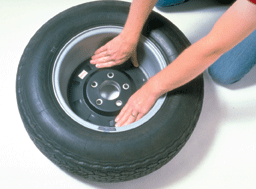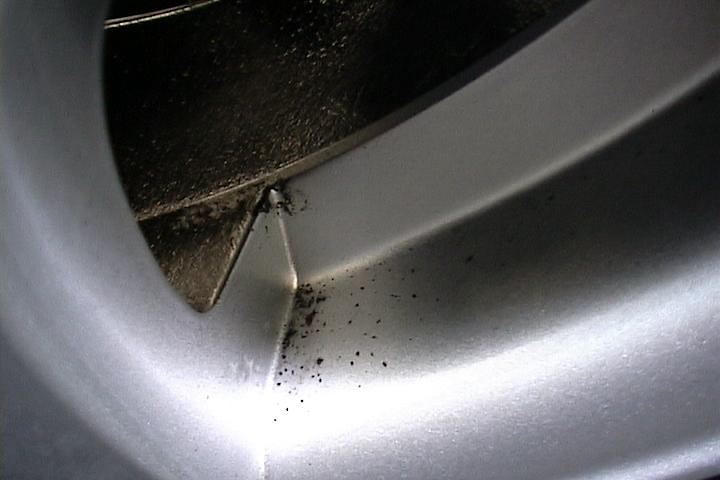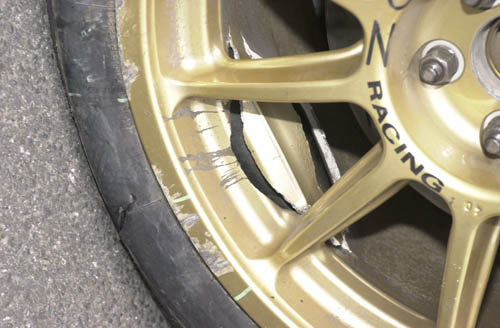You’re washing your vehicle and those alloy wheels, you spent almost a thousand dollars on, look terrible. They are scratched and peeling, or maybe even bent and cracked. Can they be restored, or must they be replaced?

Unlike regular steel wheels that are usually less expensive to replace rather than repair, expensive alloy wheels can be brought back to like-new condition for much less than the price of a new wheel. Repairing aluminum wheels is extremely complicated, so restoration should be done by a trained professional. Repairs require specialized equipment, knowledge of alloy metallurgy and lots of experience. Finally, an improperly repaired wheel can be a safety issue.
Just about everywhere there are companies that specialize in repairing wheels. Like any repair business, some do great jobs, others don’t. Take a good look at a shop and some its finished work before committing. Members of local car clubs often can make recommendations. Take wheels to wheel repairers rather than a store that sells new wheels. The latter will often want to sell you a new wheel even though your wheel could be repaired.

A competent wheel repair shop will thoroughly check out a wheel before attempting a repair. This includes checking radial and lateral runout. Radial runout is how much the wheel’s diameter varies. Typically a dial gauge measuring is place on the rim’s outer circumference and the wheel is turned. The maximum up and down motion of the dial gauge in thousands of an inch is the amount of radial runout. Lateral runout is measured by repeating the procedure, but with the dial gauge perpendicular to the rim. It is a measure of the wheel’s side-to-side wobble. Unless the wheel is severely bent, it can usually be straightened to like-new specifications.
The shop will also check for cracks and other defects. For a thorough inspection, the wheel should be removed from the vehicle and the tire removed from the wheel. Cosmetic damage including scrapes, clear coat or paint peeling, discoloration, oxidation and curb “rash” are usually correctable. Whether a crack can be repaired depends on its location and size. Minimally damaged lug nut holes can be repaired by first machining then inserting a thin steel insert is installed into the alloy wheel. Otherwise the hole can be welded shut, then re-machined. The wheel must be replaced if the lug hole damage is too severe, otherwise the wheel cannot be properly torqued. Even wheels with breaks in the bead flange area can be repaired, if the breaks is no more than about four-inches.

Here are some tips to prevent wheel damage, or at least keep it to a minimum.
If you hit a pothole hard or run into a curb, inspect your wheels, or have a wheel shop do it, as soon as possible A bent wheel can flex as you drive so a small crack can spread. Then the wheel must be replaced.
Under-inflation can result in wheel damage. Keep low profile tires properly inflated. Indeed, running at the maximum pressure recommended can decrease the risk of damage, but check the tires periodically for unusual wear patterns.
Make sure that lug bolts or nuts are properly torqued since under-torquing can damage lug holes to the point where the wheel has to replaced.
If you live in the snow belt and mount snow tires or use chains, buy a set of inexpensive wheels and mount separate tires for winter use. Store the alloys with their tires installed until spring. Mounting tires correctly on modern wheels, especially low profile ones, is critical. Improper tire installation can damage the wheel. This is an especially good idea if roads are salted.
The brake dust produced by the metallic friction material that accumulates quickly on wheels is highly corrosive and abrasive. It can pit or etch wheels if not promptly removed. Removal requires the proper wheel cleaners since the wrong chemicals can stain or etch the wheels.
When washing a vehicle, do the wheels last. The very abrasive brake dust can get on your sponge and scratch the paint.
After thoroughly rinsing off the wheel cleaners, a minimum of two times, the wheels should be dried. Then apply wax or proper wheel protectant.
Never use a scouring pad or very stiff bristle brush to clean alloy wheels.
Cover wheels when cleaning tires since some tire cleaners contain chemicals that can damage the finish on alloy wheels.
Since brake dust also accumulates on the backside of wheels, wheels should be periodically removed to clean away this brake dust as well.
European cars, especially German ones, produce much more brake dust than cars built in other countries. German safety regulations require that brake pads contain graphite. While giving outstanding stopping ability, they are softer and produce more dust. Thus, they require more frequent cleaning.
Clip on wheel weights installed when balancing tires can scratch wheels or allow moisture and brake dust to attack the alloy wheel. Look for coated wheel weights. Also stick-on rather than clip on weights won’t scratch, but can be difficult to remove after they have been in place for a long time.
Consider installing a set of Kleen Wheels Dust Shields that prevent brake dust from flowing out onto the exterior of the wheel. These shields are placed on the wheel like a hubcap, but on the inside. Unlike some shields, Kleen Wheels do not impend cooling airflow so braking efficiently is not diminished. These shields are approved by the TUV, a German safety standards testing laboratory whose standard are the toughest in the world.
Those wheels with complex honeycomb webs or many spokes may look great, but can be a pain to keep clean and shiny. Avoiding them unless you like spending your weekends cleaning wheels.





